How to Care For Kalanchoe? Kalanchoes are low-maintenance plants that are a favorite for home gardens. But if you want to keep them blooming, you need to know how to care for them properly.
Kalanchoes thrive in soil that drains well and dries between waterings. Be careful not to overwater, which can cause root rot and kill the plant.
Fertilize

A great houseplant for those in cooler zones, kalanchoe produces clusters of tiny flowers in shades of red, white, pink, yellow and orange. These blooms last for several weeks and can be enjoyed indoors or out on a patio or porch.
To keep your kalanchoe healthy, fertilize it once a month with a well-balanced plant food. Use a water-soluble type that dissolves easily. If your kalanchoe is showing signs of nutrient deficiency, apply it more often until symptoms subside.
The soil kalanchoe plants are grown in should be well-draining. Potting mix that contains too much sand or clay may prevent drainage, leading to water saturation and rot problems.
Fertilize kalanchoe plants with a high-nitrogen, low-phosphorus, or balanced water-soluble mixture once a month in spring and summer. Don’t fertilize in winter, when the plant enters dormancy.
Deadhead
Deadheading your kalanchoe is the process of removing spent blooms and foliage from your plant. It is a great way to keep your plants looking their best and encouraging new growth.
Most kalanchoe varieties are self-cleaning, which means they drop their flowers naturally after blooming instead of setting seed. If you have an old variety, however, you may need to deadhead your kalanchoe regularly.
Generally, most kalanchoes need to be deadheaded about once every two weeks. You can determine when your kalanchoe is ready for deadheading by checking to see if the petals of its flowers have withered and turned brown.
Aside from deadheading, other measures you can take to care for a kalanchoe include pruning and adding more water. For example, if your kalanchoe starts to grow leggy or leaves start turning yellow, you should trim back the plant’s branches until it’s compact and rounded.
Pruning
If you want to encourage new growth and produce flowers on your kalanchoe, prune it regularly. You can do this by removing dead or damaged leaves, leggy growth, and spent blooms.
Before pruning, make sure your garden shears are clean and disinfected with rubbing alcohol or a one-to-one solution of bleach and water. This will prevent the transfer of any diseases to your plant.
You can also use a sharp pair of scissors to remove any dead or diseased leaves. This will prevent pests and diseases from entering the main plant and can help keep the kalanchoe healthy and strong.
After pruning, you may need to reduce the amount of water your kalanchoe receives as it regrows. This will encourage the plant to grow more compactly and promote a better blooming season.
Water

Kalanchoes are reasonably low-maintenance houseplants that draw you in at the garden center because of their cheerful, tiny flowers. But they can also become poor indoor plants if not cared for properly, requiring more attention once blooms are spent.
To keep your kalanchoe alive and flourishing, water it only when the soil feels dry to the touch. You can check whether it needs more water by sticking your finger into the potting mix.
As indoor plants, kalanchoes do well in temperatures that range from 55°F to 80°F. However, freezing temperatures kill them, so if you live in areas where winters are cold, make sure your plant is sheltered from frosty weather.
Kalanchoes enjoy long periods of darkness during the winter, which reset their bloom cycle and encourage reblooming in spring. They also appreciate bright, indirect light during the day. You can place kalanchoes in a west- or south-facing window, but avoid placing them directly in the sun as it can scorch their leaves.
